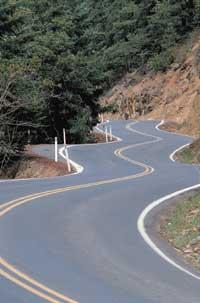New roads: driving on oil
In our environment things have changed little since the civil war ended and the roads began to be paved. Asphalt agglomerate to cover the road surface has always been composed of the same components: bitumen, stone and asphalt sand. However, instead of being natural, synthetic asphalt is currently used.

Before the asphalt was used stuck in the rock. Between four and eight percent of the operation was asphalt.
Today these techniques are far away and asphalt comes out of oil refineries. In oil refining, after the extraction of gasoline, kerosene, diesel, heating diesel, etc., what remains at the end of the process is asphalt. The oil companies then add chemical additives to make asphalt bitumen.
According to the companies working on road asphalt, this process achieves a low quality asphalt filling. In fact, the best and cleanest components of oil are mainly used for fuel, as these products leave greater benefits. Thus, asphalt bitumen is made from waste. This is the reason for the need for additives.
In front of the path taken by the asphalt agglomerate, it is not strange that in the same mixture you want to add other polymers similar to bitumen.
Thus, they have long been tested with old wheels of vehicles, even with sports shoes and tennis balls, but the sessions, tests have not yet passed the experimental phase, since for various reasons it is difficult to incorporate these polymers into the agglomerate.
New regulations
Many factors that determine how asphalt should be are taken into account in the asphalt of current roads.
Among all the factors, the time that runs through the territory and the traffic that will support the road are the most important. Depending on the usual weather conditions, it will be decided whether the pavement of the road should be prepared to withstand heavy rains or should respond to heavy heat. Similarly, it will not proceed in the same way in those cases where heavy traffic or truck traffic must be supported. There are also secondary conditions: road color (red roads), no odors, degree of roughness, etc.

According to these factors, legislation will require one or another property of the asphalt agglomerate. These properties are obtained from the addition or transformation of additives in the manufacture of agglomerate.
For example, simple asphalt agglomerate is made from limestone, sand and bitumen. If you want the road to be permeable, however, you have to de-sand the agglomerate. On the contrary, to control the roughness of the road is acted with the size of the crushed limestone or the limestone is replaced by offita. But the most important transformations are due to changes in the composition of bitumen.
Importance of bitumen
Bitumen ownership mainly controls agglomerate behavior by changing temperature.
In northern countries, for example, the law requires the use of low-temperature, hard-to-break agglomerates. On the other hand, in the southern zone it obliges to use those who suffer great dilations. Between both ends, the pavement to be placed in the mountain area must be one of the two requirements.
Current artificial or synthetic bitumen are mixtures similar to natural asphalt bitumen, but they are more expensive products and other materials are known to be added.

The Department of Rheology of the Faculty of Chemistry of the University of the Basque Country has been working with synthetic polymers for many years and has seen the ideal additive to add them to bitumen: the mixture of synthetic polymers with natural polymers (asphalt) is proposed.
For its part, the company Asphalts Naturales de Campezo, the largest in the Basque Country dedicated to the manufacture of asphalt agglomerates, is interested in introducing additives in synthetic bitumens made by themselves. In this way, in addition to reducing the process, they will also have more control over the properties of asphalt agglomerate.
Thus began the project that three years ago allowed to add several polymers to asphalt bitumen. This project involves the Basque Government and the CICYT (Inter-ministerial Commission on Science and Technology), as well as the UPV and the company Campezo.
Antxon Santamaria, director of the Department of Rheology of the UPV/EHU, wanted to work on a new method to achieve this confusion. To be able to easily mix another additive to asphalt bitumen, from the beginning indicated that a gel had to be obtained.
This gel should add special properties to the asphalt agglomerate. Above all elasticity and thermal stability. Along with them, the absence of sliding is essential for the construction of the road sign.
Oil on roads

Surprisingly, this gel brings its main properties to oils, in this case recycled.
The oil that is removed from the vehicle is currently collected and put on sale for recycling, and is the one used, along with another polymer, to make the stay. 80% of the stay is oil and the rest, three-block styrene-butadiene-styrene polymer
To obtain the stay, the polymer and oil are heated and mixed. It gets its last properties when the resulting compound cools.
This project has become a doctoral thesis in development of the chemistry Mari Sol Barral. He adds that the use of oil as gel provides advantages. On the one hand it is cheap, both the purchase of these materials and the process of obtaining the classroom. On the other hand, the environment is respected as used oils are recycled.

The research is very advanced and industrial tests will be carried out shortly to use this gel on the roads. The main desired properties (elasticity and thermal stability) have been obtained. Once it has been mixed with asphalt, it remains to be discovered how to harden the product. If the result is positive, in the Natural Asphalt plant of Campezo in Andoain you can perform the mixture of asphalt and gel. To do this, only these two elements must be kept hot and moving, otherwise a decantation would occur.
From there, it is only necessary to introduce this new asphalt bitumen in the process of making asphalt agglomerate, which is very simple.
Approximately 5% of the asphalt agglomerate obtained in the process is recycled oil. This means that if for every kilometer of a new road it is necessary to agglomerate 700 tons, 35 tons of oil will be needed.
Buletina
Bidali zure helbide elektronikoa eta jaso asteroko buletina zure sarrera-ontzian










